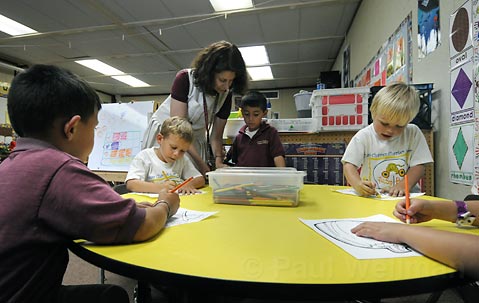The Case for Cesar Ch¡vez School

Should the Santa Barbara school board close Cesar Ch¡vez Charter School, as District Superintendent Brian Sarvis recommends? Absolutely and emphatically not. The school, an experiment in bilingual education, has been open less than 10 years, yet it is dramatically popular with parents, students, and its own teachers. While student enrollment is dropping throughout the district, Cesar Ch¡vez boasts a waiting list of more than 100 children.
While every education advocate in the country, from Newt Gingrich to Al Sharpton, preaches that parental involvement holds the key to student success, Cesar Ch¡vez has all parents volunteering at least five hours a month on campus. While other schools must deal with disgruntled teachers facing salary reductions, Cesar Ch¡vez has a faculty that willingly took an across-the-board pay cut. Last week hundreds of students, parents, faculty, and general supporters marched from Ortega Park to the districts’ board meeting to defend Cesar Ch¡vez from being shut down.
The real mystery here is why Superintendent Sarvis appears so intent on closing such a well-loved school. At first glance, the answer seems simple: consistently low standardized test scores. Admittedly, the Cesar Ch¡vez test scores are low. But a more nuanced evaluation of this unique school is required, beyond what mere numbers show.
Cesar Ch¡vez is a 50/50 bilingual school, the brainchild of parents and educators who were unhappy when our school board, in the late ’90s, voted to end bilingual teaching and embrace total immersion. Children, regardless of their English skills, were placed directly into classes appropriate to their age. The theory was that they would learn quickly enough. For many, this has proven true.
But for some parents, this was totally unacceptable; the board at that time suggested the group form their own charter school, and they did. Cesar Ch¡vez opened for business in 2001. One of the difficulties in charting its relative success is that Spanish-speaking students can not possibly score well in standardized tests during their first years. These children are not even taught English until the 3rd grade; naturally 2nd graders score zero on the language arts portion of the state tests. And that brings down the school’s overall test scores.
Also, because of space limitations, the initial student body was very small. Now comfortably ensconced in available rooms at Franklin School, Cesar Ch¡vez is able to boast its first kindergarten class equally divided between English and Spanish speakers. Students themselves can teach one another their native languages. Now is the real moment to begin testing the school’s possibility, not to close it down.
School supporters hope Sarvis and the board will come to the same conclusion after they complete formal talks with the school’s governance committee, as required by the school’s founding charter. One would have hoped that Sarvis would have exhausted this process before concluding that the school was an unmitigated educational disaster. Sarvis claims that the State Board of Education will pull the plug on Cesar Ch¡vez, possibly as early as December 15, because of the poor test results. And the state board may try. That’s why we need our elected school boardmembers to unite in vigorous defense of an educational experiment that’s been embraced by the community it has striven to serve. In the face of such challenges, Santa Barbara residents can ill-afford bureaucratic fatalism on the part of our elected representatives. It’s hard to imagine the state would intervene against a school in the face of such support.
The question confronting the board is not one merely of test scores. America’s unique system of local school boards was designed to give parents a major voice in charting the educational course of their children. Was it not our school board’s decision, albeit with different members and with a different superintendent, to grant Cesar Ch¡vez a charter in the first place? Is it not the role of charter schools to offer alternatives in an obviously flawed system that otherwise requires one method of education to fit all children?
Most likely the school can continue to improve; most likely the district can offer some important guidance. But the board must defend the wishes of the people it represents and help their children survive, if possible, the rigid, bureaucratic rules of our state-run school system. In both word and deed, the parents, teachers, and children associated with the Cesar Ch¡vez Charter School have borne eloquent witness to their desire for educational choice. Now it’s time for the boardmembers to take heed and take action.



